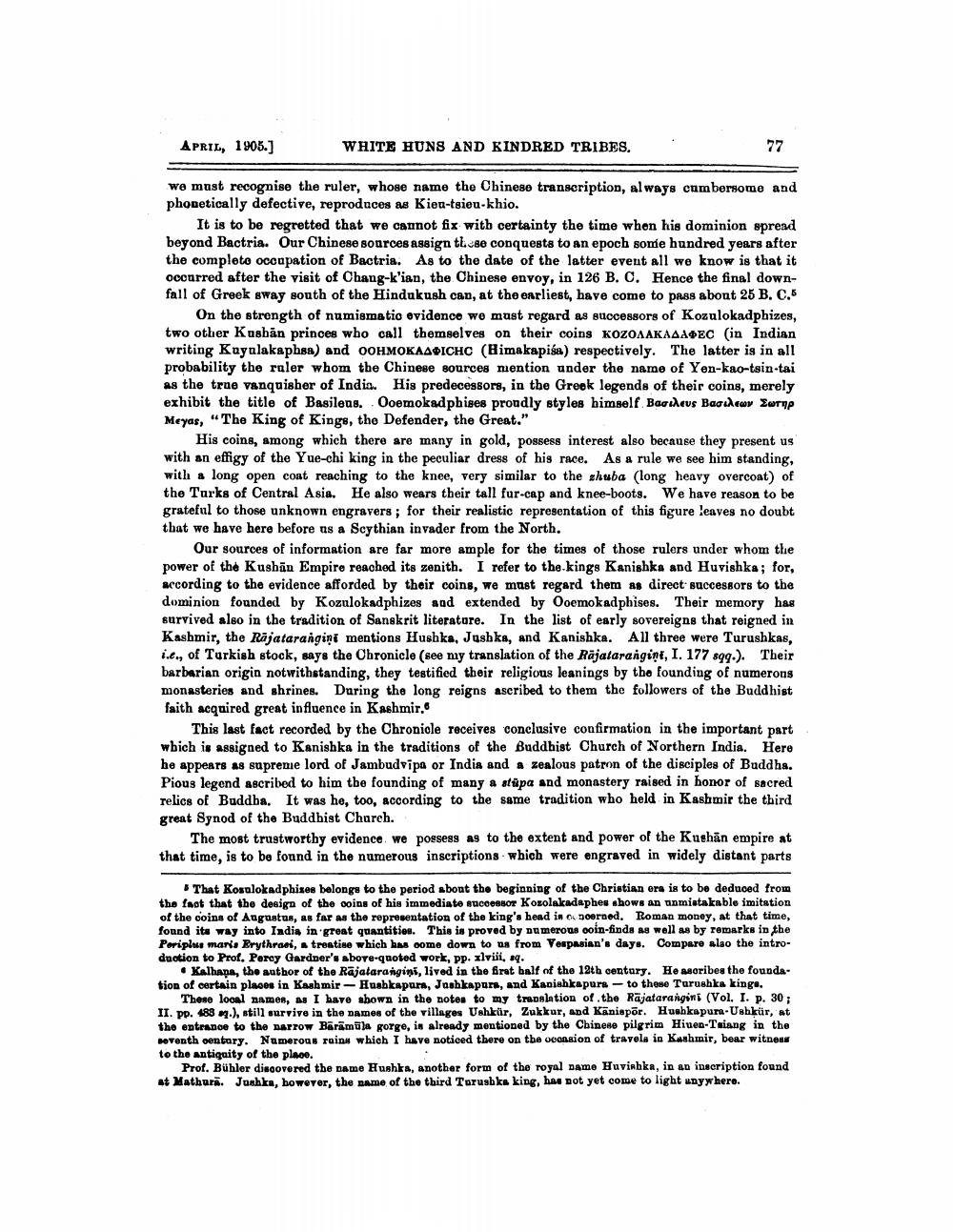________________
APRIL, 1905.)
WHITE HUNS AND KINDRED TRIBES.
we must recognise the ruler, whose name the Chinese transcription, always cumbersome and phonetically defective, reproduces as Kieu-tsieu-khio.
It is to be regretted that we cannot fix with certainty the time when his dominion spread beyond Bactria. Our Chinese sources assign thuBe conquests to an epoch some hundred years after the completo occupation of Bactria. As to the date of the latter event all we know is that it occurred after the visit of Chang-k'ian, the Chinese envoy, in 126 B. C. Hence the final downfall of Greek sway south of the Hindukush can, at the earliest, have come to pass about 25 B. C.5
On the strength of numismatio evidence we must regard as successors of Kozulokadphizes, two other Kusban princes who call themselves on their coins KOZOAAKAAADEC (in Indian writing Kayalakaphsa) and OOHMOKAADICHC (Bimakapisa) respectively. The latter is in all probability the ruler whom the Chinese sources mention under the name of Yen-kao-tsin-tai as the true vanquisher of India. His predecessors, in the Greek legends of their coins, merely exhibit the title of Basileus. Ooemokadphises proudly styles himself Baciles Baguer Ewrop Meyas, "The King of Kings, the Defender, the Great."
His coins, among which there are many in gold, possess interest also because they present us with an effigy of the Yue-chi king in the peculiar dress of his race. As a rule we see him standing, with a long open coat reaching to the knee, very similar to the rhuba (long heavy overcoat) of the Turks of Central Asia. He also wears their tall fur-cap and knee-boots. We have reason to be grateful to those unknown engravers; for their realistic representation of this figure leaves no doubt that we have here before as a Scythian invader from the North.
Our sources of information are far more ample for the times of those rulers under whom the power of the Kushan Empire reached its zenith. I refer to the kings Kanishka and Huvishka; for, according to the evidence afforded by their coins, we must regard them as direct successors to the dominion founded by Kozulokadphizes and extended by Ooemokadphises. Their memory has survived also in the tradition of Sanskrit literature. In the list of early sovereigns that reigned in Kashmir, the Rajatarangini mentions Hushka, Joshka, and Kanishka. All three were Turushkas, 1.c., of Turkish stock, says the Chronicle (see my translation of the Rajatarangint, I. 177 899.). Their barbarian origin notwithstanding, they testified their religious leanings by the founding of numerous monasteries and shrines. During the long reigns ascribed to them the followers of the Buddhist faith acquired great influence in Kashmir.
This last fact recorded by the Chronicle receives conclusive confirmation in the important part wbich is assigned to Kanishka in the traditions of the Buddhist Church of Northern India. Here he appears as supreme lord of Jambudvipa or India and a zealous patron of the disciples of Buddha. Pious legend ascribed to him the founding of many a stupa and monastery raised in honor of sacred relics of Buddha. It was he, too, according to the same tradition who held in Kashmir the third great Synod of the Buddhist Church.
The most trustworthy evidence, we possess as to the extent and power of the Kushän empire at that time, is to be found in the numerous inscriptions - which were engraved in widely distant parts
That Kosolokadphises belongs to the period about the beginning of the Christian era is to be deduced from the fact that the design of the soins of his immediate sDCOBBor Kozolakadaphes shows an onmistakable imitation of the coins of Augustus, as far as the representation of the king's head in ou boerned. Roman money, at that time, found its way into India in great quantities. This is proved by numerous ooin-finds as well as by remarks in the Periplus mari, Erythrani, treatise which has oome down to na from Vespasian's days. Compare also the introduotion to Prof. Percy Gardner's above-quoted work, pp. xlviii. q.
• Kalhana, the author of the Rājatarangini, lived in the firat half of the 12th century. He ascribes the foundation of certain places in Kashmir -Huabkapura, Jashkapura, and Kanishkapurs to these Turushka kinge.
These local names, as I have shown in the notes to my translation of the Rājatarangini (Vol. I. p. 30; II. Pp. 488 m.), still survive in the names of the villages Ushkür, Zakkur, and Känispār. Huuhkapura Usbkür, at the entrance to the narrow Baramula gorge, is already mentioned by the Chinese pilgrim Hiuen-Tsiang in the roventh century. Numerous rains which I have noticed there on the consion of travels in Kashmir, bear witness to the antigaity of the place.
Prof. Bühler discovered the name Hushka, another form of the royal dame Huvinhka, in an inscription found at Mathura. Jushka, however, the name of the third Torusbka king, hoe Dot yet come to light unywhere.




